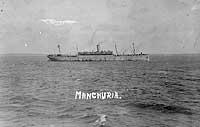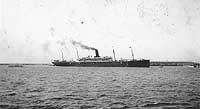
Ten of the U.S. Navy's plumb-bow WWI era transports had one smokestack and four masts. One, the smallest and by far the oldest, had been a Navy ship since 1902 and saw limited wartime trans-Atlantic service. Three were veterans of the U.S. merchant marine and the rest were former German commercial steamers. Half of the group entered Navy service in 1919, while the rest served both during and after the conflict.
Seven of these ten ships had blocky superstructures close to, or below, one-third of overall ship length, reflecting their commercial employment in the combined passenger and cargo trades. These vessels were of similar, though hardly identical appearance. Two others had lower and somewhat longer superstructures. The oldest of the group was of unique configuration.
One ship, at over 20,000 gross tons, was quite large by the standards of single-smokestack vessels. Six were in the 13,000 - 14,000 gross ton range, while the three measured 10,000 tons or less.
This page features a table (with links to individual ships) of World War I era U.S. Navy passenger liner type transports with one smokestack and four masts, plus one photograph of each ship in this group.
Click each ship name to access that ship's complete Online Library entry.
Click the small photographs to prompt a larger view of the same image, and the words "Picture Data" to access the Picture Data Sheet for that image.
TEN SHIPS with ONE SMOKESTACK and FOUR MASTS, subdivided as follows:
One quite large ship:
 Picture Data |
Two relatively large sister ships, built in the United States:
 Picture Data |
 Picture Data |
One relatively large ship, built in the United Kingdom:
 Picture Data |
Three relatively large ships, built in Germany:
 Note: Armistice markings and bulwark at bow Picture Data |
 Picture Data |
 Picture Data |
Two medium-size ships, both built in Germany:
 Picture Data |
 Picture Data |
One relatively small ship, quite different from the others in this group:
 Picture Data |
NOTES:
| If you want higher resolution reproductions than the digital images presented here, see: "How to Obtain Photographic Reproductions." |
Page made 14 March 2007
Link changed 21 December 2009